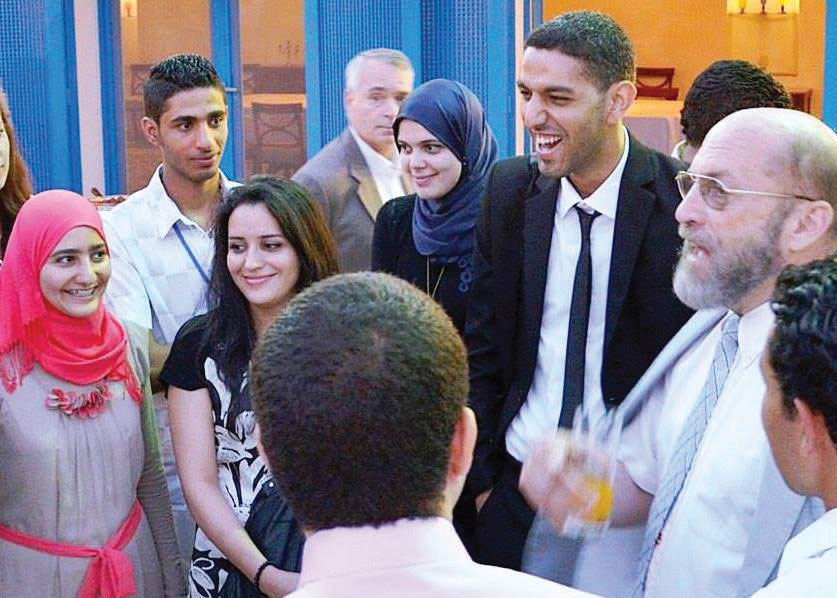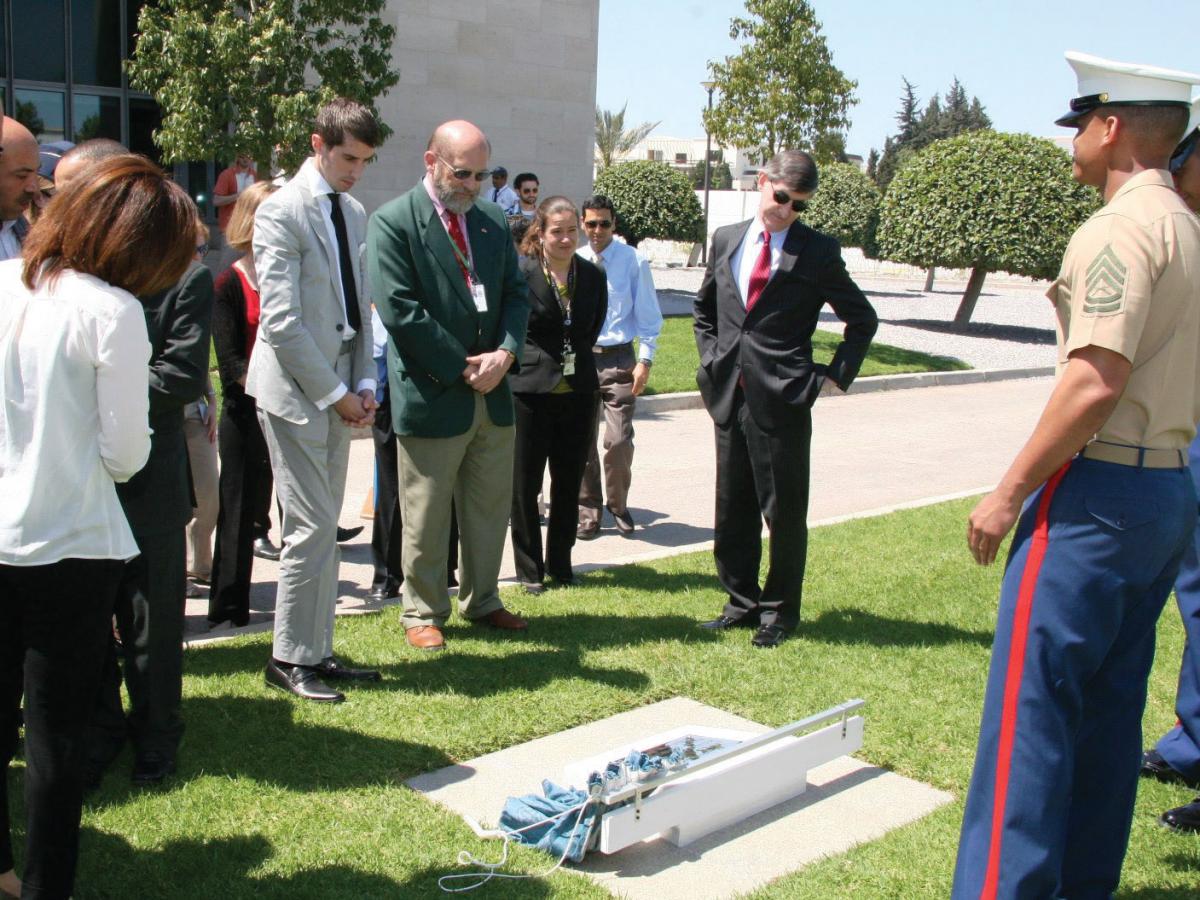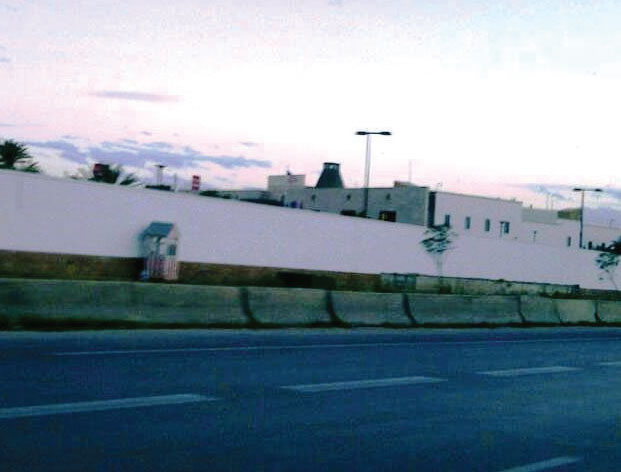Keeping Embassy Security in Perspective
A veteran FSO takes a critical look at risk tolerance—or the lack thereof.
BY JAMES L. BULLOCK

A pre-departure reception for Tunisian YES exchange students in 2013. Jim Bullock is at right.
Courtesy of Jim Bullock
I never met the late U.S. ambassador to Libya, J. Christopher Stevens, but along with many friends and colleagues I deeply mourn his untimely death. By all accounts, he was a gifted diplomat and a steadfast colleague, whose active engagement, language skills and cultural sensitivity demonstrated the very best of the Foreign Service and are traits we should both honor and transmit systematically to our new FS colleagues. Instead, in their zeal to minimize the risks inherent in representing our country overseas, some are drawing precisely the wrong lessons from Chris Stevens' sacrifice.
To put it bluntly, Amb. Stevens died because violent extremists attacked our consulate facility in Benghazi three years ago and killed him. Let’s not blame him for doing his job. As Foreign Service personnel, together with other government civilians and employees of nongovernmental organizations who work alongside us in the field, we sometimes find ourselves “in harm’s way” because that is the only way we can do our jobs. Our objectives do not become less compelling just because some danger is involved.
I watched this over-emphasis on minimizing risk grow steadily during my three-decade Foreign Service career, and the phenomenon continues today. One way it manifests itself is in the “creeping militarization” of our diplomacy. For a variety of reasons, soldiers are increasingly being asked to take over civilian functions overseas, and not just in countries with a significant U.S. military presence. Even functions that remain under State’s control, like embassy security, are now heavily influenced by military priorities and requirements. Embassies now have “force protection.”
But not all problems have military solutions. I say this as someone who hasn’t always been a civilian. In both high school and college I was in the Reserve Officers’ Training Corps, and I later spent several years as a naval officer before joining the Foreign Service. During all my years in the Foreign Service, I often worked with the military, as I do now in my work as a rehired annuitant.
Everyone understood that being secure, by itself, could never be any mission’s primary goal. I am not sure we all share that consensus anymore.
A Trend Gains Momentum
When the U.S. embassy in Beirut was bombed in April 1983, killing 63, I went there on temporary duty to replace the wounded public affairs officer. Despite a fluid and dangerous situation, I was allowed to drive myself around the city to keep our many U.S. Information Service programs on track.
A few months later, after suicide bombers struck the Multinational Force barracks in Beirut, killing 299, Navy Admiral Bobby Inman chaired a commission to review our overseas security procedures. His commission recommended, among other things, new construction standards for diplomatic compounds and expansion of State’s Bureau of Diplomatic Security.
DS was reorganized, and regional security officers began reporting directly to their deputy chiefs of mission rather than through their administrative (now called management) officers. RSOs were given larger budgets to manage, with broader liaison responsibilities. They focused on ensuring safe environments in which they and their colleagues could operate effectively. Everyone understood that being secure, by itself, could never be any mission’s primary goal. I am not sure we all share that consensus anymore.
As other terrorist incidents followed, our security apparatus continued to expand—and became an increasingly public concern. In December 1988 Pan Am 103 was destroyed by a bomb, killing 243 passengers, 16 crew members and 11 civilians on the ground in Lockerbie, Scotland. An anonymous warning, transmitted in a State Department cable, had been posted at the U.S. embassy in Moscow, where journalists had access. Following complaints after the crash that the U.S. government should have shared the threat information more widely, a “no double standard” policy was adopted, resulting in more public scrutiny of embassy security decisions.

The April 2013 rededication of a plaque in memory of temporary staffers from Tunis killed in the 1983 bombing of Embassy Beirut. Presented by Beirut locally employed staff members to their colleagues in Tunis, the original was destroyed by the mob that attacked Embassy Tunis in September 2012. Viewing the plaque, at front left to right, are Information Officer Stephen Kochuba, PAO Jim Bullock and Ambassador Jacob “Jake” Welles.
Courtesy of Jim Bullock
Ten years later, in August 1998, when truck bombs went off simultaneously at the U.S. embassies in Dar es Salaam and Nairobi, hundreds were killed or wounded. Again, DS received additional resources, at the expense of funds for programs. And after the Sept. 11, 2001, attacks by al-Qaida, President George W. Bush launched the “Global War on Terror,” and everyone was talking about security. A new Department of Homeland Security began operations in March 2003.
Then, as I noted at the beginning of this piece, on Sept. 11, 2012, militants attacked a small, makeshift consulate compound in Benghazi, killing Amb. Stevens and three other American employees. Ever since, overseas security has been a club for politicians to use against one another. After the State Department’s Accountability Review Board sharply criticized State for “systemic failures” and “deficiencies” at senior levels, increased security was ordered worldwide.
The View Is Different from Outside
Meanwhile, I had retired in 2009 from my final Foreign Service posting, as public affairs officer in Paris. I had grown accustomed to all of the security procedures that had grown up over the years. Subjecting our visitors to searches and metal detectors, and requiring them to leave their electronic devices at the door had become routine for us “on the inside.”

Flowering cactus plants are a traditional security barrier in semi-arid Tunisia.
Courtesy of Jim Bullock
But when I went to work for the American University in Cairo and returned to visit my former colleagues at the U.S. embassy there, I experienced those same layers of security “from the outside.” Gaining entry to a U.S. embassy, even as a recently retired U.S. diplomat, was a real ordeal; it reminded me of a cartoon that ran in the FSJ following the release of the Inman Report. It showed a walled compound with no doors or windows, only a U.S. flag rising from within. Two puzzled locals are walking the perimeter. “How do you get in?” one asks. “You don’t,” the other replies. “You must be born in there.”
My former colleagues, however, could easily visit me at AUC, even though it, too, was a “high-value target” for those opposed to any U.S. presence in Egypt. The U.S. government continues to pour large amounts of grant money into the university and other NGOs to run programs that Foreign Service personnel formerly would have managed. The difficulty in gaining access to embassy or USAID compounds is not, of course, the only reason for outsourcing; but it surely is an argument for working through outside partners.
When I returned to Washington, I signed up to work as a When Actually Employed reemployed annuitant. In late 2012 the Bureau of Near Eastern Affairs asked me, along with several other WAEs, to help staff our embassy in Tunis, which had been on “ordered departure” since a violent mob attack on Sept. 14, 2012, that had left both the embassy and the nearby American School seriously damaged. The embassy’s core chancery building, recently built to Inman Commission standards, had kept the mob out, and not a single embassy employee had been physically injured during an hours-long siege. The real problem was political, not physical: The Tunisian government had failed to respond effectively to the initial attack.
Nevertheless, still spooked by the news from Benghazi just three days earlier, Washington had ordered the evacuation of Embassy Tunis. Three months after that, I arrived to find one of the strictest security regimes I had ever experienced outside of a combat zone.
The embassy’s Tunisian employees had shown amazing resilience and resourcefulness following the attack, working from their homes via email and fax to close out the fiscal-year books far from their evacuated American colleagues. For the public affairs section, that closeout involved hundreds of thousands of dollars in grants, which, despite the attack, continued to be disbursed. Managing those programs was one of the reasons I was sent to Tunis. Otherwise, almost all public programs and other routine operations were suspended.
In addition to a small number of permanent American staff brought back, without dependents, a few others, including WAEs like myself, were gradually brought in on temporary duty, mostly in security and construction-related positions. Tight restrictions were placed on official visitors, with prior authorization from State’s under secretary for management required. All public diplomacy-related visits to Tunisia, including by regional support staff, were halted.
Ever since Benghazi, overseas security has been a club for politicians to use against one another.
Outside, relative calm prevailed, even as the birthplace of the Arab Spring was undergoing the most important political transition in its history. Inside, priority was going to security construction and to maintaining a low profile. Temporary staff were initially lodged in remote hotels (some were later put into vacant houses) and driven to and from work in armored shuttles. In-country travel was discouraged, and representation was minimal.
I wanted to get out, to see old friends and contacts from my two earlier assignments in Tunis, and I felt I could really accomplish something important in that way—but there was little encouragement to do so. Reduced staffing severely curtailed most public outreach.
Security As the Primary Goal?
The one thing that was not limited was the security operation. Throughout my six months in Tunis, our staff meetings typically focused on security and construction issues. Across the entire mission, relatively few U.S. employees had outside contact work as their primary responsibility.
Off duty, I was generally able to move about Greater Tunis more or less freely. Thanks to email and Facebook, I found many old friends and contacts. Some had become “ancien régime,” but they nonetheless offered an important window into our understanding of what was happening in Tunisia. Meanwhile, official Washington still had Benghazi in its teeth, and the focus was on security, not outreach.
Repeated requests by the embassy to go off ordered-departure status and bring back dependents were rebuffed. Yet just across the highway, the American School had put itself back into operation within days. Sure, there was still credible threat reporting—but we saw very little violence. Nearby, our posts in Morocco were still open, as was the embassy in Cairo, surely a more dangerous place.

USIS staff with departing PAO Jim Bullock, center in striped shirt, in the courtyard of the American Center, Tunis, in 1996.
Courtesy of Jim Bullock
The net effect of this continued security-first posture was to reduce the U.S. government’s presence and operational effectiveness in Tunisia at a crucial time. What program outreach we were doing was largely in the hands of NGOs, who could bring in staff and program support without an explicit green light from M.
The embassy’s public library (Information Resource Center) was essentially closed to the general public, both because advance clearance through the RSO was required for access and because the space itself had been requisitioned as the embassy’s training classroom. The public affairs section’s multipurpose room had likewise been taken over by temporary security staff. Since even routine access for outside visitors required 24-hour advance notice, I often met contacts at cafés just beyond the barbed-wire barriers.
Barbed wire atop and alongside high blank walls, running parallel to one of the country’s main highways, gave the embassy compound the look of a federal penitentiary. Once, I suggested to the construction folks that we use cactus (a traditional Tunisian security barrier) in place of the concertina wire, and add colorful “Info-USA” panels on the side of the perimeter wall facing the highway. The cactus, I was told, would be too expensive. (Compared to the overall cost of maintaining that huge compound on top of a reclaimed swamp?) The murals? Maybe, someday. (If anyone from the Bureau of Overseas Buildings Operations is reading this, please consider!)
Before I left for home in July 2013, I managed to hold one successful representational event—at a hotel. Shortly after that, at the embassy’s Fourth of July reception, I heard the ambassador assure a small and tightly controlled assembly that the United States would “never be chased from Tunisia” and that we were “there to stay.” I hope he’s right about that, but the temporary closure of 19 U.S. embassies and consulates worldwide the next month in response to various security concerns was not encouraging.
The net effect of this security-first posture was to reduce the U.S. government’s presence and operational effectiveness in Tunisia at a crucial time.
Getting Real Value for Risks Taken
When we decide to put diplomats and other civilian workers into a country, we need to ensure they have the tools they need to accomplish the tasks set for them. And because risk can never be eliminated, it must be managed.

“Fortress America” looms along Tunis’ main highway, with high blank walls awaiting concertina wire, in 2013.
Courtesy of Jim Bullock
Somehow few challenge the risks we face from tropical disease or endemic crime, only from politically motivated violence. For that, host governments have the primary responsibility to protect our official facilities under the 1961 Vienna Convention on Diplomatic Relations and the parallel 1963 Convention on Consular Relations. As politicians and pundits club each other with talk of “sending in the Marines” (or the 101st Airborne), let’s admit that it is almost never practical or desirable to apply purely military solutions to diplomatic security issues.
We need to maintain good “force protection,” of course, and we need to minimize mistakes, but we also need to get out of our offices to do our jobs. That means tolerating a certain level of risk. As the recent knife attack on Mark Lippert, our ambassador in Seoul, demonstrates, we can never completely take the danger out of diplomacy. What we can do is take a critical look at security’s increasing share of our limited resources, and ensure that we get real value for the risks we do take.
If, as I have read, our overall budget for security is now four times our budget for public diplomacy, let’s reexamine our goals. Just “staying safe” cannot be primary. Let’s transmit to our next generation of diplomats those virtues and values Amb. Stevens gave his life for—and achieve real benefits for the nation.
Read More...
- Accountability Review Board (ARB) Report (U.S. Department of State)
- What Makes Embassies Secure? (PBS, Sept. 13, 2012)
- The Inman Report of the Secretary of State's Advisory Panel on Overseas Security (FAS.org)
- Securing Our Embassies Overseas (U.S. Department of State)


